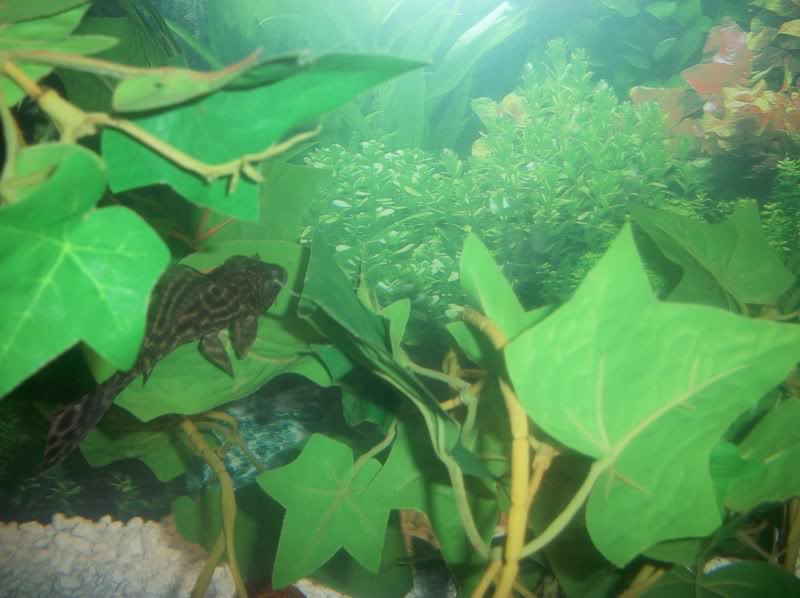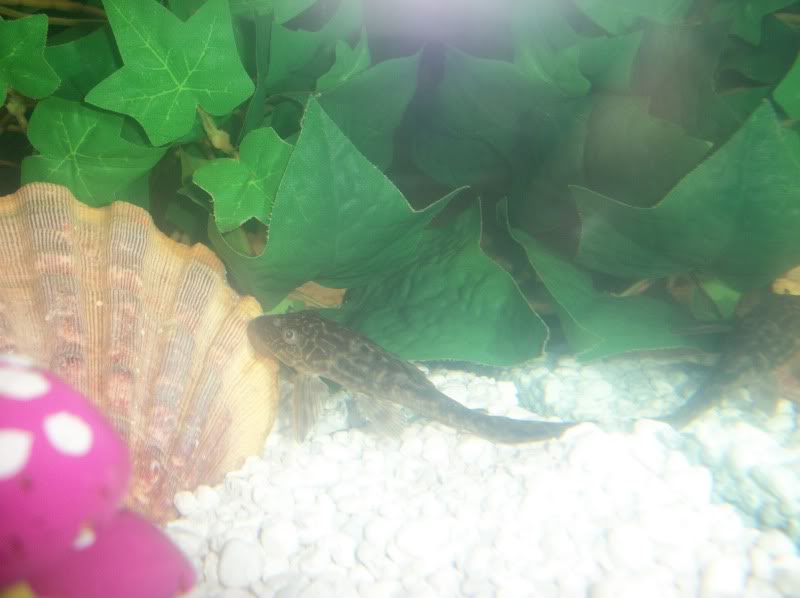I'm seeing a oversight amongst a lot of fish-keepers with Plecos.
The trend is to just throw a few algae wafers in after lights out and think that that is enough supplementary food for them.
Its not!
Plecs may start off just fine eating algae in the tank and/or algae wafers along with whatever scraps they find as small juveniles, but as they mature their needs change.
Most Plecs are very opportunistic omnivores
*, in other words they'll eat just about anything they can get a hold of but primarily subsist on vegetables/fruits.
A plecs digestive system is designed for a diet high in bulk fiber and low in protein, they need large amounts of vegetable/fruit matter and occasional protein. Their digestive system is designed to handle a lot of bulk material to attain a their nutritional needs, they need more than just a few low bulk/high protein algae wafers and whatever food they find leftover or a little algae growing in the tank.
None but the largest tanks could support enough algae to feed even a medium sized Plec, and while enough algae would have bulk it is very low in nutrition.
A Plec without fiber bulk (vegetable/fruit) in his diet, is a Pleco that feels like he's starving most of the time, even if he's getting enough nutrition to survive and grow.
It'd be like be like you getting only a slice of bread per day that has enough calories, protein, fats, sugars and asst vitamins for you to survive and grow...
But you'd be horrendously hungry the rest of the time.
Excellent daily vegetable supplements are, romaine, spinach and other leafy green lettuces (Iceberg is very high in bulk but very low nutritionally.) that have been blanched
* first, cut/sliced zucchini, cucumber, sweet potato, broccoli stems, peas and beans (blanched and skinned), and others.
Fleshy fruits of various types can be fed too, Plecs in the wild feed on fruit fallen into river from overhanging trees. Papaya, breadfruit, cantaloupe/honeydew melon are a few examples, experiment and find what your fish likes.
It takes most Plecs a few feedings to discover and realize these are food, but after that there is no keeping them away. Some fish will even guard these foods to keep other fish away.
I found it very hard when housed with other fish to get such delights as worms and small scraps of cut fish/shrimp, shrimp pellets and other sinking food tablets/pellets down to the plecs.
Other fish can be sooo greedy.
My solution was to load their zucchini or cucumber with shrimp pellets, carnivore sticks and so on, like cloves on a ham.
Just securely attach it with clips or rubber bands to a rock or wood, makes it easy for your Pleco to find and eat it.
*As stated above "Most Plecs are very opportunistic Omnivores", but some are primarily carnivore (e.g. Zebras etc) and others (e.g. Panaque etc) require wood (Yes, wood!) in their diet to survive.
*Blanching; too quickly prepare a food by placing it in or pouring boiling water over it. Leafy greens 5-30 seconds, or longer for other vegetables, the idea is to wilt or soften the food so its easier to eat.
There are hundreds of different Plecos, please research your specific Plec and its needs thoroughly.
I implore all of you with plecos who do not currently regularly supplement their diet with vegetables/fruit and/or other appropriate food sources to do so.
I guarantee you will notice a increase in growth and improved physical appearance.
For detailed profiles/specific needs of various Plecos I highly recommend these two sites.
They are the Pleco equivalent of
www.oscarfish.com
www.planetcatfish.com
www.plecofanatics.com
...........................................................................................................
Some of the members at
www.monsterfishkeepers.com have contributed excellent replies to this article as posted/stickied there,
http://www.monsterfishkeepers.com/forums/showthread.php?t=42856
I have learned much from this site and their input is worth linking/crossposting.
...........................................................................................................
**StiffMeister** nice article. gives a good impression on why to feed veggies next to pellets. you wrote it in a nice way. i do want to comment on daily veggies. might be nic efor the fish but not for the tank. i usually feed veggies once or twice a week. water will go to **** if done more often and filters clog way faster. i also keep the veggies in the tank for a mere couple of hours. the fish dont mind as they will eat it straight away and it will deffo keep the water up.
..................................................................................................................................
**davo** lol, some plecos are lucky with algae wafers, and just get the scraps from other fish, and is there to eat algae. i dont tend to use pellets, and all my plecos get a massive range of foods and the ratio is changed for each pleco depending on its preference towards meaty foods, or vegetarian. You can feed them so many different vegetables- basically everything, and there is a wide variety of meats to eat. even the most herbivorous plecos should get meat, and you can see the difference just in their colours. the same goes for the need of a bit of veg for the carnivores. its important for the digestive tract- they need the roughage. The other thing is many plecos NEED bogwood- and its not just the panaques. its important as it is part of the teeth grinding, roughage intake and important lignin. its easy to tell the difference between a well fed pleco and one that isnt (not just looking at weight).
a few things- i dont see any need to blanch- thats just getting rid of nutrients for no reason- the plecs should easily be able to eat it as it is
- plecos dietry needs change as they age- not just in amount of foods but also the food type
-i dont consider these as supplementary feedings- these should be their diet. supplementary gives the impression its something to be added too.
otherwise good article
**WyldFya**To add to that, although in general plecs that start going after slime coat CAN be a sign of poor nutrition offered by the keeper, it isn't always a sign. Often if they acquire the taste, they will not stop going after it, and even can start hunting other fish. I have had three now that have become not only slime coat suckers, but also hunters. They were fed 1 market shrimp every other day. That still didn't stop them. It depends on the individual pleco.
..................................................................................................................................
**davo** Right this has been a long time coming to make the answer to "pleco feeding" as a sticky, and this thread had the best basis ChileRelleno
So to add to what has been said, here is some more info.
Bascially ALL plecos are OMNIVOROUS. Like every animal, plecos need a balanced diet.
However, it is important to look up your species to know the ratio of what to feed your pleco- carnivore:vegetarian. Carnivores need some vegetables in there diet, and vice versa.
The size/age of your pleco also has a massive bearing on what you should feed it. For example, hypostomus plecostomus as a juvenile, needs a lot of roughage in its diet, and leans more towards the vegetarian side of an omnivore. However, as it grows and reaches sub-adulthood more and more protein rich foods should be given.
Another, commonly looked over food source is bogwood. Natural softwoods make it easy for a pleco to gain lignin, which is a chemical compound found in cell walls etc. it doesnt degrade easily, but plecos still need a good supply as it helps keep their digestive tracts in order. they also gnaw their teeth down aswell as the wood fibres add to their roughage intake. It is absolutely essential to some pleco genus, such as panaques.
Feeding at night time, may be considered better as plecos are a nocturnal species, and are more active and look for food at night time. Hence, feeding just before lights out is a good thing, to let them feed in the dark.
Feeding plecos together: Think of the compatibility of your plecos, some species will easily out compete others for food, and hence some will starve as a result.
Here is a list of some suitable food sources for plecos:
*I have not including the many types of sinking pellets and flake food, because although a useful addition I dont believe them to be as useful as fresh or frozen foods such as those below and would never use them as a main diet, but merely supplement.
Meat/Protein based foods:-
Worms- bloodworms, blackworms, nightcrawlers etc (a side note, i've never had a young carnivorous plec refuse bloodworms)
Mysis
Beefheart
Prawn
Shellfish- mussels, cockles etc
Squid
Silversides
Spirulina
Brine Shrimp
Crustaceans
Other Insect Larvae
Fish Eggs
Krill
Daphnia
Chicken Liver
Vegetables (remember to wash all veggies of unwanted bugs and blanching veggetables isn't necessary- it takes away nutrients)
Cucumber
Zucchini
Potatoes (I would soak these for a long time and wash thoroughly as they contain a lot of starch that is bad for water quality, although otherwise a great food source)
Sweet Potatoes
Shelled Peas
Broccoli
Carrots
Lettuces
Cabbage
Courgette
Yams
Parsnips
Squash
Suede
Spinach
Beans
Others:-
Melon
Bogwood
Mango
Apple
Kiwi
Rotting Leaves (or live)
Please add any feeding tips or techniques here to help squash the myth of "plecos eat algae".
Cheers
**WyldFya**Don't forget pumpkin! My plecs went NUTS over pumpkin.
..................................................................................................................................
**COL** Just for the record, there are only two genera of loricariidae that have been shown to eat wood for nutritional value (roughage can be obtained from other sources), those being the infamous panaque and two (and perhaps more) species of lasiancistrus. For some odd reason, the morphologically similar hypostomus-cochliodonts lack the necessary gut microbes to extract nutrients from wood with the efficacy of larger panaque, though they, along with several other hypostomini and pterygoplichthyini tribe fishes show limited capacity to digest woody substances. Also, lignin is more or less impossible to digest to any significant degree. Rather, it is the hemicellulose that is so vital to the panaque palette.
All in all, it really comes down to what kind of pleco you've got; there are as many different dietary niches in nature as there are species of loricariids. Just in ancistrini alone, you've got a plethora of different fishes with different dietary needs:
Ancistrus/chaetostoma/lasiancistrus, and to a lesser extent, pseudolithoxus/hopliancistrus/dekeyseria-periphytonic grazers inhabiting consistently shallower waters, where the natural awfuchs makeup is represented largely by algal growth and decaying vegetation. Thus, a diet rich in fiber and other vegetable products is preferred, although, as with other grazers, microrganisms are consumed in the process of grazing, thus, protein should be offered, though with some care.
Megalancistrus/leporacanthicus-these closely related genera are almost exclusively invertebrate-feeders, specializing in feeding on snails (leporacanthicus), small to medium sized crustaceans such as river prawns, predatory insect larvae, worms, etc, and sponges. In accordance, these fish prefer high protein, low fat fare; mollusks and crustacea commonly available in the fish markets (clams, shell on shrimp to wear down the teeth, and, to a lesser extent, white fish) are perfect. Both genera, as previously stated, feed heavily off of freshwater porifera, and thus, seem to be fairly attracted to, and may even need fiber to substitute the vast amounts of spongin ingested while feeding. This, perhaps, explains why these fish are relatively prone to bloat in comparison to other "carnivorous" species, though it is hard to say how closely spogin and cellulose compare, molecularly. A fair amount of wood is also found in gut analysis, presumedly the side affects of grazing on spongal growths attached to various woody structures.
Hypostomus/pterygoplichthys/acanthicus/psuedorinelepis/peckoltia -nondescript feeders that will take anything and everything. With unspecialized villiform teeth, these fish will eat anything. From the sand sifting aphanotolurus and squalliforma, to the wood-grazing hypostomus cochliodon, all of these fish, regardless of habitat, are dietary generalists and feed on both vegetation and protein. Both should be fed heartily to ensure that specimens grow sufficiently while staying bloat-free.
Scobinancistrus/hypancistrus/psuedacanthicus-these are the generalized carnivores, so to speak. Some are adept scavengers, others, skilled predators (large scobinancistrus, for example, frequently pluck small, free swimming fishes from the water column above them), and all can tolerate relatively high levels of fat and crude protein. However, in optimal conditions, they should still be fed relatively high quality, lean foods, akin to the dietary recommendations given to the aforementioned leporacanthicus. Similarly, fiber should still be provided, as their natural diet still allows for more fibrous victuals, including beans, seeds, and nuts, which are commonly consumed by all three.
Panaque/lasiancistrus/hypostomus cochliodon-wood. What more is there to say?
Spectracanthicus/various peckoltia/baryancistrus/parancistrus-these deep water limnivores feed exclusively on the bio-film deposited onto various aquatic surfaces by decaying vegetation and animal matter, along with the microorganisms found alongside this organic debris. Because of their deeper water habits, dietary demands of such species are less focused on algae and more on protein. Henceforth, high-protein foods should be fed at least once a day, in addition to a heavy feeding of vegetable matter, corresponding with the dietary mixture found in the awfuchs consume by these fish. Like their shallower water, more herbivorously inclined relatives, they should be fed frequently, corresponding with their grazing lifestyle.
This is a more or less comprehensive list to the dietary needs of subfamily hypostominae, disregarding the rarer fish (cordylancistrus, neblinichthys, etc.) or the veritable scientific trash heaps (ancisti, hemiancistrus, etc.). Enjoy.






